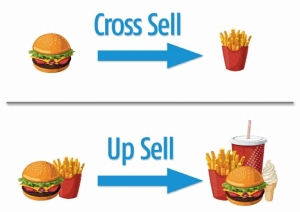Upsell / Cross Sell
Cross Sell and Upsell are relatively old and established sales tools.
Cross Sell involves the sales of additional items related (or sometimes unrelated) to a previously purchased item, while Upsell involves the increase of order volume either by the sales of more units of the same purchased item, or the upgrading into a more expensive version of the purchased item. Within the context of customer relationship management, increasing penetration of products and services with customers has become a valuable strategy for customer development, for several reasons.
• First, there is a belief that it costs five times less to serve an existing customer than to acquire a new one .
• Second, reported response rates from Cross Sell and Upsell efforts are 2 to 5 times greater than cold sales .
• Third, Cross Sell leads to broader scope for the customer relationship, increasing not only share of wallet but also the firm’s “share of mind” with the customer.
• Fourth, by broadening the scope of relationship, Cross Sell increases the actual and psychological costs of switching, improving retention.
• Fifth, as the customer buys more products and services from the firm and broadens the relationship, the organization learns more about the customer’s needs and preferences, improving your ability to target marketing efforts.
This information advantage, added with the higher costs of switching, produces a virtual local monopoly for your company, which allows you then better able to compete for your customers than other companies that do not have an established relationship or access to the same information about their needs and preferences.
In today’s competitive environment many service transactions are now mediated by information technologies, eliminating human communication, thereby reducing the opportunities of Cross Sell as practiced in the past. For this reason, Cross-Sell had to evolve by complementing human intuition and reasoning with Predictive Analytics.
Rather than relying on a sales or services representative to decide to whether to cross-sell and which item to offer, modern cross-selling utilizes analytical tools to study the customer’s past behaviour, correlate this information with similar customers, and then identify potential service product opportunities at each contact with the customer.
Analytical Tools that TDT Can Offer to improve Cross Sell Opportunities There are two major analytical tools that make cross-selling possible in a CRM environment: Acquisition Pattern Analysis and Collaborative Filtering. We can offer both of these tools to you.
Acquisition Pattern Analysis. The main purpose of the Acquisition Pattern Analysis is to identify the next logical step for the customer, in terms of product / service acquisition based on the pattern of previous acquisitions and on the pattern of other customers. For example, a business person who buys a Blackberry may next acquire a carrying case, followed by additional memory, and applications etc. The basic theory behind Acquisition Pattern Analysis states that there is a natural sequence of acquisition for services and customers can be measured in a common uni-dimensional scale measures their “service maturity” so that a mature customer will have a high probability of using most of the services, while a less mature customer will only use the most common services that are available .
Collaborative Filtering. Collaborative Filtering tools focus on making recommendations based on the associations between the product recently purchased and others offered by the firm. The basic idea in collaborative filtering is to predict a customer’s preferences as a weighted average of other customers’ preferences, using weights that are proportional to the correlations between the preferences by the focal customer and all “collaborators” over a common set of products.

